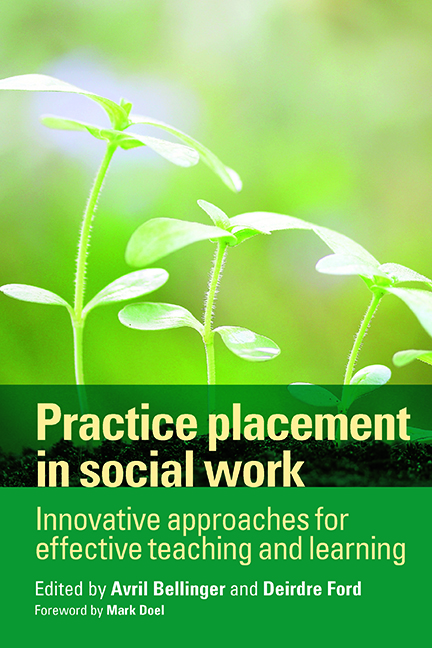Book contents
- Frontmatter
- Dedication
- Contents
- Foreword
- Notes on contributors
- Introduction
- One Student-led services
- Two International placements: learning from a distance
- Three The outside looking in – an independent social worker’s experience of practice educator work
- Four ‘Do you have to be white to pass this course?’ Developing support for black and minority ethnic students in a predominantly white area
- Five Men in social work education: building a gendered alliance
- Six Hidden in plain sight: use of an arts-based method for critical reflection
- Seven Getting our hands dirty: reconnecting social work education as if the earth matters
- Eight Social media for students in practice
- Nine Developing placement capacity in the third sector
- Ten Observations of student practice: what difference does observer qualification make?
- Eleven Filling the gap: constructive responses to the erosion of training standards for practice educators
- Twelve The concept of integrity in relation to failing and marginal students
- Thirteen Cultivating discretion: social work education in practice and the academy
- Index
Six - Hidden in plain sight: use of an arts-based method for critical reflection
Published online by Cambridge University Press: 01 September 2022
- Frontmatter
- Dedication
- Contents
- Foreword
- Notes on contributors
- Introduction
- One Student-led services
- Two International placements: learning from a distance
- Three The outside looking in – an independent social worker’s experience of practice educator work
- Four ‘Do you have to be white to pass this course?’ Developing support for black and minority ethnic students in a predominantly white area
- Five Men in social work education: building a gendered alliance
- Six Hidden in plain sight: use of an arts-based method for critical reflection
- Seven Getting our hands dirty: reconnecting social work education as if the earth matters
- Eight Social media for students in practice
- Nine Developing placement capacity in the third sector
- Ten Observations of student practice: what difference does observer qualification make?
- Eleven Filling the gap: constructive responses to the erosion of training standards for practice educators
- Twelve The concept of integrity in relation to failing and marginal students
- Thirteen Cultivating discretion: social work education in practice and the academy
- Index
Summary
Introduction
This chapter explores the technique of employing imagery with students to support their development of critical reflection. My intention was to work productively with the frustration I perceived from students who appeared to find it difficult to understand that critical reflection demands the acknowledgement of the social location and embeddedness within particular social systems that influence our ability to act. I developed an accessible way of working with students in order to approach critical reflection in a non-textual way. The chapter draws on my work with nine social work, nursing and occupational therapy students undertaking placements in the health and social care statutory setting in which I was based.
As a practising social worker and educator, I am bound by time constraints and am aware of their impact on students. I therefore use images to stimulate discussion, reflection and learning at the end of a supervision session as part of a ‘wind-down’ and a retreat into a more interior, reflective space. I follow the same method in a responsive, ad hoc manner in an effort to overcome the ‘stuck-ness’ that students sometimes experience. For example, in response to a statement from a student such as ‘I keep being told I need to show more critical analysis’, I utilised a visual technique. In order to evaluate this use of an arts-based method to stimulate critical reflection by student social workers, I employed visual autoethnography as the principle way of monitoring responses and outcomes. What follows is a review of the literature, an account of the technique and student reactions, together with a summary of my learning for future use.
The case for an additional method
In her work around reflection, Fook (2002) has surmised that critical incident analysis is only productive when a person's thinking is not ‘fixed’ and resolved, but, rather, still open to movement. When I question students following statements such as the previous one, responses invariably fall into the following two types:
• ‘I am able to undertake critical thinking but lack the time to do so and will utilise it properly when I have managed to read more’; and
• ‘I don't yet fully grasp what critical thinking entails and therefore find it difficult to implement.’
- Type
- Chapter
- Information
- Practice Placement in Social WorkInnovative Approaches for Effective Teaching and Learning, pp. 87 - 102Publisher: Bristol University PressPrint publication year: 2016



